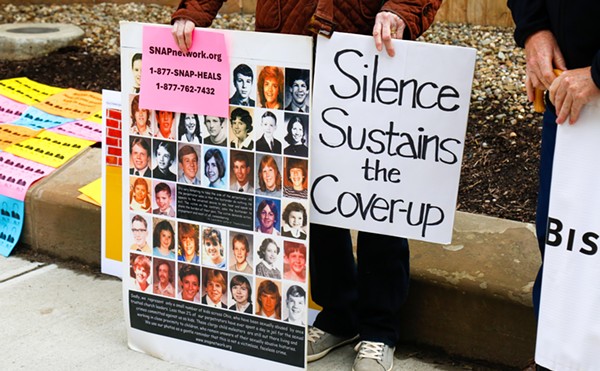Kevin Houser heard about Jorge Martinez from other addicts, who described him as a doctor who offered "easy access to pills." He had begun using painkillers for a back injury, and by the time he found Martinez, he was hooked.
Houser assumed that Martinez was a legitimate physician -- just one who didn't scrutinize his patients. The doctor didn't even bother to give him a physical exam, says Houser. "It was just strictly go in and get my shots and get my prescriptions [every] Monday."
The shots were nerve-block injections -- a procedure designed to dull pain using an anesthetic -- costing thousands of dollars per visit. Houser hated them. They didn't seem to work, and they hurt like hell. But they were central to Martinez' treatment plan. If Houser had to endure a little pain to get his Percocet and Valium, so be it.
He was hooked on euphoria, which made him willing to sit in Martinez' waiting room for up to five hours each Monday. At the end were tickets to a high -- pages torn from a prescription pad. As long as the pills kept coming, it was all worth it.
"He didn't care how long you had to wait, because he knew you'd wait for the drugs," says Houser. "What killed me is that he'd only write them for one week."
Then Martinez began asking him for "donations," supposedly to offset his rising malpractice insurance. Houser would kick the doctor $20 each visit. When he didn't have the cash, he apologized profusely, promising to pay next week.
"He made it look like if I didn't give the $20, I wouldn't get the scrips," Houser says.
Eventually, he stopped seeing Martinez, in part because he was trying to get clean. But about five months later, he received a letter from workers' comp, informing him that it would no longer cover his treatment. The bill listed dates for recent visits, appointments Houser hadn't made. Martinez had also billed workers' comp for twice the number of shots Houser actually received.
Little did he know that the DEA had reached the same conclusions. Through Martinez' billing records and informants inside his offices, the agency had uncloaked a massive scheme of drug peddling and fraud.
Houser got off easy; he eventually got clean. But some patients left Martinez' care broke, blind, hurt -- even dead.
Last September, Martinez was hauled away by the feds from his million-dollar Bath home, the same day they raided his offices in Boardman and Parma. In his mug shot, Martinez' face is round and pudgy, with wispy black strands slicked back over a receding hairline.
Out of nearly a million doctors registered with the Drug Enforcement Administration, Martinez was among the mere 42 arrested last year. The feds accuse him of using nerve-block injections excessively, dispensing drugs for nonmedical purposes, practicing insurance fraud, and accepting "donations" in exchange for drugs, among other crimes.
His arrest is part of the agency's OxyContin Action Plan, an attempt to attack abuse of the prescription painkiller. Combining the hysteria surrounding OxyContin with the sight of clean-cut physicians, white collars askew, being dragged around in handcuffs, the busts became headline-grabbers.
The basics of each case are similar. They usually involve distributing opioids -- the general name for drugs like OxyContin, Percocet, and Vicodin -- either to known addicts or to patients who eventually overdosed. But each case has its unique drama, and Martinez' story is no different.
If you believe the DEA, his was a Horatio Alger tale gone bad: An immigrant doctor who arrived from Mexico, built a multimillion-dollar practice, and then resorted to fraud to maintain his lifestyle.
The statistics alone are damning. In 1998, he ranked 153rd in reimbursement among Medicaid doctors in Ohio, receiving upwards of $68,000. A year later, Martinez rocketed to first place, getting reimbursed for more than $539,000. The drastic increase was mirrored in his Medicare and workers' comp reimbursements, which jumped from a combined $83,000 in 1998 to more than $474,000 the following year. By 2001, Martinez was receiving more than $1 million a year in workers' comp reimbursements alone.
The numbers set off statistical alarm bells. By the time the feds concluded their investigation, the FBI, the DEA, and the Department of Health and Human Services were all involved. None of the agencies will talk about the specifics of the case. But when they raided Martinez' offices, investigators confiscated more than 200 boxes of records. They also possessed hundreds of hours of audio and video recordings. Investigators posing as patients, along with at least one of Martinez' employees, had made tapes for the government.
Most alarming was the doctor's fondness for nerve-block injections. He administered more than anyone in Ohio, averaging nearly 40 units per patient, at a cost of more than $1,800 per visit. The second-ranked doctor averaged just three units per patient, at a cost totaling slightly more than $100.
According to experts, nerve blocks work for some patients, but are far from successful for most. And generally speaking, there is no reason for a doctor to administer more than a handful of injections each year. Yet Martinez often injected patients on a weekly basis, netting him thousands of dollars for a brief treatment.
To get patients to submit to the routine, the doctor turned them into addicts, allege the feds. According to the indictment, the dosages of painkillers prescribed by Martinez "were likely to cause and did cause patients to become dependent on those medications, to become dependent on defendant for providing those medications, and to abuse those medications."
When patients were hooked, contend the feds, Martinez could force them to take injections in exchange for pills.
In all the doctors-as-dealers stories, there exist certain categories of wrongdoing. Some physicians are just dolts, lacking the street smarts to realize that their patients are dopers. Others are aware that they're dealing with addicts, but will look the other way as long as they get paid. In the worst cases, however, physicians intentionally exploit patients for the greater good of their bank accounts.
Mary Salvino will tell you about getting hurt. The 66-year-old from Leetonia will recount how, one day in 1994, she was driving to New Castle, Pennsylvania, and out of nowhere, her car was rear-ended. Both vehicles were totaled.
The impact jarred Salvino's back. The pain was unbearable, so she went to see Martinez. He didn't take away her pain, but he tried to take her money.
"He ripped me off big-time," she says.
Martinez treated her the same way he treated so many patients. Every Tuesday, she'd visit his office for her weekly injections. "They hurt like hell," she says. "The needles were so bad that my husband sat on the other side of the room and turned his head when [Martinez] started with the needles."
Worse, she wasn't getting better.
Martinez gave the injections without the benefit of fluoroscopy, an X-ray that allows shots to be located precisely. Martinez has argued that fluoroscopy is not a necessity, which seems to be technically correct. Yet studies have shown that it substantially reduces the risk of unintended injury. In other words, it's the type of precaution patients like Salvino usually expect, especially when large needles are involved.
Furthermore, according to the feds, not only was the quantity of shots used by Martinez dubious; so was the quality. Like a college-town bartender watering drinks, he often used cheap drugs in the injections, but billed the government for more expensive medications.
Sitting in the doctor's waiting room each week, Salvino couldn't help but overhear the conversations among employees about patients and their insurance. She became suspicious of his billing practices. "If [patients] didn't have good insurance, he wouldn't take them," she says.
It was one of the many things about Martinez that concerned her -- things that eventually led her to stop seeing Martinez -- but she thought her bills were covered. She says she signed an agreement, which essentially stated that Martinez would accept whatever her insurance would pay -- a common practice.
Yet, in November 2001, four years after she stopped seeing the doctor, Salvino received notification that Martinez was suing her for tens of thousands of dollars in unpaid bills. "He was after everything I had," she says. "And he didn't care where he put me."
Not only did the lawsuit contradict the agreement she signed, but it included bills for X-rays Martinez never took, she claims.
Attorney Paul Giba, Salvino's lawyer, says the doctor "lost" the paperwork Salvino signed. Apparently, after shelling out tens of thousands of dollars, the insurance company suspended payment to Martinez until he submitted a treatment plan -- a fairly common request. Either Martinez didn't submit a plan, or the insurance company rejected it. Whatever the case, Giba says, the blame wasn't Salvino's.
"I did a lot of walking the floor and crying at night," she says.
She still has back pain today. But at least she has her money.
Martinez' suit was dismissed -- the statute of limitations had long since passed.
With a degree from the University of Guadalajara in Mexico, Martinez clambered up the American medical ladder, first working at hospitals, then striking out into private practice. Success didn't come easily; several of his offices closed. But at the time of his arrest, he was a millionaire with a thriving practice.
Not many people associated with Martinez are willing to speak about him. Knowing the many lawsuits he has launched in the past, some fear legal ramifications. Others are fearful of igniting his volatile personality, which they say includes a wide vindictive streak. Making it more difficult to piece together his past is that friends, enemies, and court documents often contradict one another.
Martinez has allegedly married and divorced three times. Though their divorce was messy, one wife, Jaime Guida-Tate, with whom he has a daughter, still defends her former husband and is skeptical of the case against him.
"I think he's a good doctor," she says without hesitation. "I think [his case is] a little bit of a witch-hunt. He liked working with patients. He wanted to take care of them."
Darlene Surato was also involved with Martinez. She managed several of his practices and oversaw most of his assets in several corporations. Though Surato declined to comment on her relationship with Martinez, court documents indicate that it splintered in 1998, just days before Christmas.
Surato called police to their Bath home, claiming that Martinez had drunkenly struck her, hit her with television remotes, pulled her hair, broken her glasses, and locked her in a bedroom. "He was going to kill me I felt," she wrote in a court statement. Surato was subsequently granted a restraining order.
Yet their split seemed to have a greater effect on Martinez' business. Surato was responsible for billing at his various offices, which were located in Pittsburgh, Akron, and Lorain, as well as his current offices in Boardman and Parma. During their relationship, both were raking in hundreds of thousands of dollars a year, and they shared a million-dollar home. But according to the feds' timeline, Martinez' venture into fraud came shortly after the couple split.
Good help, apparently, is hard to replace.
"I will not go to the cross quietly like the Lord Jesus Christ," Martinez writes from a Painesville jail. The government "will have to drag me and I will go screaming to their abuses and injustice."
To Martinez, persecution and prosecution seem to be the same thing. His lawyers would prefer that he keep quiet, and he has taken their advice literally, refusing interviews. But Martinez writes letter after letter from jail.
If spoken, his densely spaced words would leave little room for breath. He employs capital letters for emphasis as he describes the case against him as a "Quasi-legal Shake Down" and a "Forfeiture-Induced witch-hunt." He accuses one investigator of "PERJURY," and says the government is using "OxyContin HYPE to falsely accuse me and many other pain doctors of Drug Dealing."
"I know I am going to be found innocent because I haven't done anything wrong, illegal let alone criminal. This is just a set up," he writes.
When mailed a long list of questions about his life and the charges against him, Martinez responds with letters that skirt many of the questions and most of the details. While not specifically addressing his treatment of Houser, he defends his requests for donations to pay his malpractice insurance and writes that he has "never given a Nerve Block to someone that did not need it, nor have I given one pill to a patient that did not need it." Martinez also challenges investigators' motives and abilities to judge medical necessity, writing that such investigators entrap pain doctors to "promote their careers."
"He was a good doctor, I thought," says Shirley Elliott. After seven back surgeries, she went to Martinez for her pain. Nothing suggested that his conduct was anything but aboveboard. "It was a shock to me when [his arrest] happened."
Elliott's name is one of many provided by Beverly Kennard, a patient who has become Martinez' spokeswoman of sorts. Kennard doesn't merely submit to an interview; she jumps at the chance, tirelessly placing follow-up phone calls to ensure that any information helpful to Martinez is made available. "The patients suffer right along with him," she says.
Kennard says that Martinez treated his patients with compassion and respect, unlike the way in which pain patients are often treated. "There's a social stigma attached to you if you're on narcotic medication," she says. Martinez took her pain seriously, she adds, and worked hard to ease her suffering.
Another patient Kennard refers to states the case made by Martinez supporters more simply. "He gave me medications I needed that other [doctors] didn't," Francis Denson says. "I'm sorry to lose a doctor."
But even some of the doctor's admirers noticed something wrong in his office. Jeff Muchewicz, who praises the way Martinez treated his hip pain, acknowledges that some patients were "pillheads" and that Martinez mentioned "donations," though Muchewicz didn't think anything of it.
Letters from Martinez express an overriding theme: The government is out to get him. He points to the employee who secretly taped him at work with patients who were "in nude conditions," as if the feds' motivation were softcore porn.
The tapes show nothing criminal, he alleges, and were made only for revenge. After all, the employee's daughter, who also worked for Martinez, had been arrested for stealing his prescription pads.
But this leg of the government's "conspiracy" isn't quite as simple as Martinez makes it out to be. The daughter was a young office assistant who escorted Houser from the waiting room to the examination room every week. Left to sit together week after week, the two got to know each other well. One day, the daughter asked Houser what pills the doctor was giving him. He rattled off a list.
"Then she asked, 'What did you really want?'" Houser says.
He was already getting Percocet, but he really wanted OxyContin. The stronger pill fetches a dollar per milligram on the street -- meaning that, depending on the dosage, one pill might bring as much as 80 bucks.
They didn't speak again about Oxy for months, until Houser got a call at home. The daughter said she received a chintzy Christmas bonus from Martinez, so she took one of his prescription pads. She offered Houser a deal: She would have her boyfriend forge prescriptions for Oxy, if Houser would get them filled and sell them. They would split the money.
Houser agreed, but he had no intention of selling the pills. How could he sell perfectly good Oxy, when he could take it himself?
He still had to give her money, though, so they would meet at an A&W down the street from Martinez' office. Houser would go inside and order a burger "the way she liked it." Then he would put the money in the bottom of the bag, walk outside, and hand her the sack.
What she didn't know was that Houser wasn't selling the Oxy. "All of the money I gave her came out of my wife's paycheck," he says with resignation.
Their plan eventually fell apart. When Houser attempted to fill one forged prescription, the pharmacist told him it had to be confirmed with the doctor. Houser left the drugstore and never went back -- he knew the prescription would never be filled. But the drugstore had his name, and police found him easily. Detectives thought he'd stolen the prescription pad, but Houser told them about the office assistant and her boyfriend.
Houser pleaded guilty to possession of a forged prescription. Both he and Martinez say that the young office assistant pleaded guilty too.
However, neither the woman nor her mother, the informant, could be reached for comment, and there is no record of the woman's case in Mahoning County. That could mean either that she was never charged or that her case was sealed, possibly in exchange for cooperating against Martinez. Whatever the truth, the feds aren't talking.
Yet the incident doesn't reflect well on the doctor either. Martinez continued Houser's weekly routine of prescriptions and shots for months after the arrest.
"He'd still see me to get that money," Houser says.
The doctor, it seems, was not the kind to jettison a paying customer.
Salvino wasn't the only patient who sought treatment from Martinez and went away in worse circumstances. While he was practicing in Pittsburgh in the early 1990s, Martinez settled a malpractice suit filed by a patient. A woman seeing him for hip pain apparently suffered nerve damage caused by one of Martinez' injections, says a lawyer familiar with the case. The doctor paid a substantial sum to settle the matter, though specifics are sketchy, since the case file was sealed and a gag order was put in place.
Another malpractice suit has been lingering in Mahoning County since 2002. Ronald Bauman went to Martinez because of debilitating migraines. The doctor recommended injections. According to his affidavit, Bauman received "sometimes as many as 18" shots in his head and eyes each time he visited Martinez.
In an affidavit, Bauman says he gradually lost his vision in one eye and alerted Martinez. The doctor brushed his concern aside, telling him the condition was only temporary. But Bauman's vision got worse. Moreover, the injections weren't relieving his pain.
When Bauman continued to complain, Martinez told him "to sue [him], and that he'd give me the number of a good attorney."
"I have since discovered that blindness, among other things, is a potential side effect of Depo Medrol when it is injected into the head," Bauman says in the affidavit.
Bauman declined to be interviewed. However, an affidavit dated May 2005 reveals that neither his eyesight nor his headaches have improved.
In a civil case filed this year in Cuyahoga County, Virginia Ribis claims that Martinez' regimen of pills and needles made her an addict. Furthermore, she claims that Martinez failed to perform proper examinations and tests before treating her. In a handwritten response to the court, Martinez offers a simple defense: "The plaintiff is an adult and was well-informed about the side effects of the medications she takes," he wrote defiantly, adding that Ribis' suit "just comes to clog the court."
In certain ways, Martinez' defense is plausible. Patients should take some responsibility for their own choices. But when so many patients are making similar claims, it's difficult to ignore the pattern that emerges. Especially when patients start dying.
The most discussed patients in the feds' indictment are known only by their initials, "B.K." and "J.L."
John Lancaster, a car salesman from Parma Heights, was injured in a car accident and began seeing Martinez in 1999. According to a lawsuit filed by his wife, Karen, her husband had a history of dependence on drugs. She believes the doctor not only neglected his addiction, but purposefully perpetuated it.
At his Parma office, Martinez prescribed numerous drugs to Lancaster, including Kadian, Valium, Vicodin, Zoloft, and Zanaflex. Lancaster was also the recipient of Martinez' injection regimen, which "exceeded the bounds of medical protocol," according to the suit.
On September 5, 2001, Martinez gave Lancaster numerous injections. The suit alleges that he fell unconscious for several hours at the doctor's office. Lancaster returned home, but remained ill. Two days later, Lancaster's wife drove him to the hospital "in acute respiratory distress," with drugs in his system prescribed by Martinez. He remained in critical condition at Deaconess Hospital until he died six days later. He was 42.
Though Karen Lancaster declined interview requests, Martinez maintains that his treatment did not kill her husband. "John Lancaster had OxyContin and cocaine in his blood when he died," the doctor writes.
He takes the same approach to the death of Blair Knight.
Martinez' treatment of Knight was relatively boilerplate, at least by the doctor's standards. Knight came to his Boardman office seeking treatment for pain from several orthopedic injuries, including a back injury, caused by a wall that collapsed at a construction site. Martinez prescribed painkillers, including OxyContin, and also administered injections.
"There's no clear indication of what exactly he was being injected with or what it was supposed to do," says Richard Ashley, the administrator of Knight's estate, calling the contents of the injections a "secret potion."
According to his family's suit, Knight had a history of depression and had previously received psychiatric care. They say that Martinez exploited Knight's vulnerable condition, prescribing drugs that would "perpetuate a highly dependent state."
"The family was concerned about how he was being treated," Ashley says. "He wasn't really himself" when he was being treated by Martinez.
Hours after his last visit, on January 8, 2001, Knight was found dead in his Ravenna home with numerous drugs in his system, including lethal levels of OxyContin.
"We've got a 35-year-old man who died shortly after coming back from receiving treatment from Dr. Martinez," says Ashley.
Yet Martinez puts the blame squarely on Knight. "If Mr. Knight would have followed the instructions of taking one pill every 12 hours -- as he had hundreds of times before -- Mr. Knight would be alive today," the doctor writes.
Regardless of who's right, the lawsuits will have to wait. Martinez' criminal trial began this week in Cleveland. If he's found guilty, the feds stand first in line to seize any ill-gotten assets. And depending on the outcome of the criminal case, the doctor's malpractice insurer may try to void his coverage, leaving the patient who sued him with nothing but lawyer bills.











